Outline Introduction Background Distributed DBMS Architecture Distributed Database

Outline Introduction Background Distributed DBMS Architecture Distributed Database Design Semantic Data Control Distributed Query Processing Distributed Transaction Management Transaction Concepts and Models Distributed Concurrency Control Distributed Reliability Distributed DBMS Parallel Database Systems Distributed Object DBMS Database Interoperability Concluding Remarks © 1998 M. Tamer Özsu & Patrick Valduriez Page 10 -12. 1

Transaction A transaction is a collection of actions that make consistent transformations of system states while preserving system consistency. concurrency transparency failure transparency Database in a consistent state Begin Transaction Distributed DBMS Database may be temporarily in an inconsistent state during execution Execution of Transaction © 1998 M. Tamer Özsu & Patrick Valduriez Database in a consistent state End Transaction Page 10 -12. 2

Transaction Example – A Simple SQL Query Transaction BUDGET_UPDATE begin EXEC SQL UPDATE PROJ SET BUDGET = BUDGET 1. 1 WHEREPNAME = “CAD/CAM” end. Distributed DBMS © 1998 M. Tamer Özsu & Patrick Valduriez Page 10 -12. 3

Example Database Consider an airline reservation example with the relations: FLIGHT(FNO, DATE, SRC, DEST, STSOLD, CAP) CUST(CNAME, ADDR, BAL) FC(FNO, DATE, CNAME, SPECIAL) Distributed DBMS © 1998 M. Tamer Özsu & Patrick Valduriez Page 10 -12. 4

Example Transaction – SQL Version Begin_transaction Reservation begin input(flight_no, date, customer_name); EXEC SQL UPDATE FLIGHT SET STSOLD = STSOLD + 1 WHEREFNO = flight_no AND DATE = date; EXEC SQL INSERT INTO FC(FNO, DATE, CNAME, SPECIAL); VALUES (flight_no, date, customer_name, null); output(“reservation completed”) end. {Reservation} Distributed DBMS © 1998 M. Tamer Özsu & Patrick Valduriez Page 10 -12. 5

Termination of Transactions Begin_transaction Reservation begin input(flight_no, date, customer_name); EXEC SQL SELECT STSOLD, CAP INTO temp 1, temp 2 FROM FLIGHT WHERE FNO = flight_no AND DATE = date; if temp 1 = temp 2 then output(“no free seats”); Abort else EXEC SQL UPDATEFLIGHT SET STSOLD = STSOLD + 1 WHERE FNO = flight_no AND DATE = date; INSERT INTO FC(FNO, DATE, CNAME, SPECIAL); VALUES(flight_no, date, customer_name, null); Commit output(“reservation completed”) endif end. {Reservation} Distributed DBMS © 1998 M. Tamer Özsu & Patrick Valduriez Page 10 -12. 6

Example Transaction – Reads & Writes Begin_transaction Reservation begin input(flight_no, date, customer_name); temp Read(flight_no(date). stsold); if temp = flight(date). cap then begin output(“no free seats”); Abort end else begin Write(flight(date). stsold, temp + 1); Write(flight(date). cname, customer_name); Write(flight(date). special, null); Commit; output(“reservation completed”) end. {Reservation} Distributed DBMS © 1998 M. Tamer Özsu & Patrick Valduriez Page 10 -12. 7

Characterization Read set (RS) The set of data items that are read by a transaction Write set (WS) The set of data items whose values are changed by this transaction Base set (BS) RS WS Distributed DBMS © 1998 M. Tamer Özsu & Patrick Valduriez Page 10 -12. 8

Formalization Let Oij(x) be some operation Oj of transaction Ti operating on entity x, where Oj {read, write} and Oj is atomic OSi = j Oij Ni {abort, commit} Transaction Ti is a partial order Ti = { i, <i} where i = OSi {Ni } For any two operations Oij , Oik OSi , if Oij = R(x) and Oik = W(x) for any data item x, then either Oij <i Oik or Oik <i Oij OSi, Oij <i Ni Distributed DBMS © 1998 M. Tamer Özsu & Patrick Valduriez Page 10 -12. 9

Example Consider a transaction T: Read(x) Read(y) x x + y Write(x) Commit Then = {R(x), R(y), W(x), C} < = {(R(x), W(x)), (R(y), W(x)), (W(x), C), (R(y), C)} Distributed DBMS © 1998 M. Tamer Özsu & Patrick Valduriez Page 10 -12. 10

DAG Representation Assume < = {(R(x), W(x)), (R(y), W(x)), (R(x), C), (R(y), C), (W(x), C)} R(x) W(x) C R(y) Distributed DBMS © 1998 M. Tamer Özsu & Patrick Valduriez Page 10 -12. 11

Properties of Transactions ATOMICITY all or nothing CONSISTENCY no violation of integrity constraints ISOLATION concurrent changes invisible È serializable DURABILITY committed updates persist Distributed DBMS © 1998 M. Tamer Özsu & Patrick Valduriez Page 10 -12. 12

Atomicity Either all or none of the transaction's operations are performed. Atomicity requires that if a transaction is interrupted by a failure, its partial results must be undone. The activity of preserving the transaction's atomicity in presence of transaction aborts due to input errors, system overloads, or deadlocks is called transaction recovery. The activity of ensuring atomicity in the presence of system crashes is called crash recovery. Distributed DBMS © 1998 M. Tamer Özsu & Patrick Valduriez Page 10 -12. 13

Consistency Internal consistency A transaction which executes alone against a consistent database leaves it in a consistent state. Transactions do not violate database integrity constraints. Distributed DBMS Transactions are correct programs © 1998 M. Tamer Özsu & Patrick Valduriez Page 10 -12. 14

Consistency Degrees Degree 0 Transaction T does not overwrite dirty data of other transactions Dirty data refers to data values that have been updated by a transaction prior to its commitment Degree 1 T does not overwrite dirty data of other transactions T does not commit any writes before EOT Distributed DBMS © 1998 M. Tamer Özsu & Patrick Valduriez Page 10 -12. 15

Consistency Degrees (cont’d) Degree 2 T does not overwrite dirty data of other transactions T does not commit any writes before EOT T does not read dirty data from other transactions Degree 3 Distributed DBMS T does not overwrite dirty data of other transactions T does not commit any writes before EOT T does not read dirty data from other transactions Other transactions do not dirty any data read by T before T completes. © 1998 M. Tamer Özsu & Patrick Valduriez Page 10 -12. 16

Isolation Serializability If several transactions are executed concurrently, the results must be the same as if they were executed serially in some order. Incomplete results An incomplete transaction cannot reveal its results to other transactions before its commitment. Necessary to avoid cascading aborts. Distributed DBMS © 1998 M. Tamer Özsu & Patrick Valduriez Page 10 -12. 17

Isolation Example Consider the following two transactions: T 1: Read(x) T 2: Read(x) x x 1 Write(x) Commit Possible execution sequences: T 1 : T 2 : Distributed DBMS Read(x) x x 1 Write(x) Commit T 1 : T 2 : © 1998 M. Tamer Özsu & Patrick Valduriez Read(x) x x 1 Read(x) Write(x) x x 1 Write(x) Commit Page 10 -12. 18

SQL-92 Isolation Levels Phenomena: Dirty read T 1 modifies x which is then read by T 2 before T 1 terminates; T 1 aborts T 2 has read value which never exists in the database. Non-repeatable (fuzzy) read T 1 reads x; T 2 then modifies or deletes x and commits. T 1 tries to read x again but reads a different value or can’t find it. Phantom T 1 searches the database according to a predicate while T 2 inserts new tuples that satisfy the predicate. Distributed DBMS © 1998 M. Tamer Özsu & Patrick Valduriez Page 10 -12. 19

SQL-92 Isolation Levels (cont’d) Read Uncommitted For transactions operating at this level, all three phenomena are possible. Read Committed Fuzzy reads and phantoms are possible, but dirty reads are not. Repeatable Read Only phantoms possible. Anomaly Serializable None of the phenomena are possible. Distributed DBMS © 1998 M. Tamer Özsu & Patrick Valduriez Page 10 -12. 20

Durability Distributed DBMS Once a transaction commits, the system must guarantee that the results of its operations will never be lost, in spite of subsequent failures. Database recovery © 1998 M. Tamer Özsu & Patrick Valduriez Page 10 -12. 21

Characterization of Transactions Based on Application areas non-distributed vs. distributed compensating transactions heterogeneous transactions Timing on-line (short-life) vs batch (long-life) Organization of read and write actions two-step restricted action model Structure flat (or simple) transactions nested transactions workflows Distributed DBMS © 1998 M. Tamer Özsu & Patrick Valduriez Page 10 -12. 22

Transaction Structure Flat transaction Consists of a sequence of primitive operations embraced between a begin and end markers. Begin_transaction Reservation … end. Nested transaction The operations of a transaction may themselves be transactions. Begin_transaction Reservation … Begin_transaction Airline – … end. {Airline} Begin_transaction Hotel … end. {Hotel} end. {Reservation} Distributed DBMS © 1998 M. Tamer Özsu & Patrick Valduriez Page 10 -12. 23

Nested Transactions Have the same properties as their parents may themselves have other nested transactions. Introduces concurrency control and recovery concepts to within the transaction. Types Closed nesting Subtransactions begin after their parents and finish before them. Commitment of a subtransaction is conditional upon the commitment of the parent (commitment through the root). Open nesting Subtransactions Compensation Distributed DBMS can execute and commit independently. may be necessary. © 1998 M. Tamer Özsu & Patrick Valduriez Page 10 -12. 24
![Workflows “A collection of tasks organized to accomplish some business process. ” [D. Georgakopoulos] Workflows “A collection of tasks organized to accomplish some business process. ” [D. Georgakopoulos]](http://slidetodoc.com/presentation_image_h/8412c5ae0147c537d3febbd03da0efab/image-25.jpg)
Workflows “A collection of tasks organized to accomplish some business process. ” [D. Georgakopoulos] Types Human-oriented workflows Involve humans in performing the tasks. System support for collaboration and coordination; but no systemwide consistency definition System-oriented workflows Computation-intensive & specialized tasks that can be executed by a computer System support for concurrency control and recovery, automatic task execution, notification, etc. Transactional workflows In between the previous two; may involve humans, require access to heterogeneous, autonomous and/or distributed systems, and support selective use of ACID properties Distributed DBMS © 1998 M. Tamer Özsu & Patrick Valduriez Page 10 -12. 25

Workflow Example T 3 T 1 T 2 Customer Database Distributed DBMS T 5 T 4 T 1: Customer request obtained T 2: Airline reservation performed T 3: Hotel reservation performed T 4: Auto reservation performed T 5: Bill generated Customer Database © 1998 M. Tamer Özsu & Patrick Valduriez Page 10 -12. 26

Transactions Provide… Atomic and reliable execution in the presence of failures Correct execution in the presence of multiple user accesses Correct management of replicas (if they support it) Distributed DBMS © 1998 M. Tamer Özsu & Patrick Valduriez Page 10 -12. 27

Transaction Processing Issues Transaction structure (usually called transaction model) Flat (simple), nested Internal database consistency Semantic data control (integrity enforcement) algorithms Reliability protocols Atomicity & Durability Local recovery protocols Global commit protocols Distributed DBMS © 1998 M. Tamer Özsu & Patrick Valduriez Page 10 -12. 28

Transaction Processing Issues Concurrency control algorithms How to synchronize concurrent transaction executions (correctness criterion) Intra-transaction consistency, Isolation Replica control protocols How to control the mutual consistency of replicated data One copy equivalence and ROWA Distributed DBMS © 1998 M. Tamer Özsu & Patrick Valduriez Page 10 -12. 29

Architecture Revisited Begin_transaction, Read, Write, Commit, Abort Results Distributed Execution Monitor With other TMs Transaction Manager (TM) Scheduling/ Descheduling Requests Scheduler (SC) With other SCs To data processor Distributed DBMS © 1998 M. Tamer Özsu & Patrick Valduriez Page 10 -12. 30

Centralized Transaction Execution User Application Begin_Transaction, Read, Write, Abort, EOT User Application … Transaction Manager (TM) Results & User Notifications Results Scheduler (SC) Scheduled Operations Results Recovery Manager (RM) Distributed DBMS © 1998 M. Tamer Özsu & Patrick Valduriez Page 10 -12. 31

Distributed Transaction Execution User application Results & User notifications Begin_transaction, Read, Write, EOT, Abort TM Distributed Transaction Execution Model TM Replica Control Protocol Read, Write, EOT, Abort SC RM Distributed DBMS SC Distributed Concurrency Control Protocol RM Local Recovery Protocol © 1998 M. Tamer Özsu & Patrick Valduriez Page 10 -12. 32

Concurrency Control The problem of synchronizing concurrent transactions such that the consistency of the database is maintained while, at the same time, maximum degree of concurrency is achieved. Anomalies: Lost updates The effects of some transactions are not reflected on the database. Inconsistent retrievals A transaction, if it reads the same data item more than once, should always read the same value. Distributed DBMS © 1998 M. Tamer Özsu & Patrick Valduriez Page 10 -12. 33

Execution Schedule (or History) An order in which the operations of a set of transactions are executed. A schedule (history) can be defined as a partial order over the operations of a set of transactions. T 1: Read(x) Write(x) Commit T 2: Write(x) Write(y) Read(z) Commit T 3: Read(x) Read(y) Read(z) Commit H 1={W 2(x), R 1(x), R 3(x), W 1(x), C 1, W 2(y), R 3(y), R 2(z), C 2, R 3(z), C 3} Distributed DBMS © 1998 M. Tamer Özsu & Patrick Valduriez Page 10 -12. 34

Formalization of Schedule A complete schedule SC(T) over a set of transactions T={T 1, …, Tn} is a partial order SC(T)={ T, < T} where T = i i , for i = 1, 2, …, n < T i < i , for i = 1, 2, …, n For any two conflicting operations Oij, Okl T, either Oij < T Okl or Okl < T Oij Distributed DBMS © 1998 M. Tamer Özsu & Patrick Valduriez Page 10 -12. 35

Complete Schedule – Example Given three transactions T 1: Read(x) T 2: Write(x) Commit Write(x) T 3: Write(y) Read(z) Commit Read(x) Read(y) Read(z) Commit A possible complete schedule is given as the DAG Distributed DBMS R 1(x) W 2(x) R 3(x) W 1(x) W 2(y) R 3(y) C 1 R 2(z) R 3(z) C 2 C 3 © 1998 M. Tamer Özsu & Patrick Valduriez Page 10 -12. 36

Schedule Definition A schedule is a prefix of a complete schedule such that only some of the operations and only some of the ordering relationships are included. T 1: Read(x) T 2: Write(x) Commit Write(x) T 3: Write(y) Read(z) Commit R 1(x) W 2(x) R 3(x) W 1(x) W 2(y) R 3(y) C 1 R 2(z) R 3(z) C 2 C 3 Distributed DBMS Read(x) Read(y) Read(z) Commit R 1(x) © 1998 M. Tamer Özsu & Patrick Valduriez W 2(x) R 3(x) W 2(y) R 3(y) R 2(z) R 3(z) Page 10 -12. 37

Serial History All the actions of a transaction occur consecutively. No interleaving of transaction operations. If each transaction is consistent (obeys integrity rules), then the database is guaranteed to be consistent at the end of executing a serial history. T 1: Read(x) Write(x) Commit T 2: Write(x) Write(y) Read(z) Commit T 3: Read(x) Read(y) Read(z) Commit Hs={W 2(x), W 2(y), R 2(z), C 2, R 1(x), W 1(x), C 1, R 3(x), R 3(y), R 3(z), C 3} Distributed DBMS © 1998 M. Tamer Özsu & Patrick Valduriez Page 10 -12. 38

Serializable History Transactions execute concurrently, but the net effect of the resulting history upon the database is equivalent to some serial history. Equivalent with respect to what? Conflict equivalence: the relative order of execution of the conflicting operations belonging to unaborted transactions in two histories are the same. Conflicting operations: two incompatible operations (e. g. , Read and Write) conflict if they both access the same data item. Incompatible operations of each transaction is assumed to conflict; do not change their execution orders. If two operations from two different transactions conflict, the corresponding transactions are also said to conflict. Distributed DBMS © 1998 M. Tamer Özsu & Patrick Valduriez Page 10 -12. 39

Serializable History T 1: Read(x) Write(x) Commit T 2: Write(x) Write(y) Read(z) Commit T 3: Read(x) Read(y) Read(z) Commit The following are not conflict equivalent Hs={W 2(x), W 2(y), R 2(z), C 2, R 1(x), W 1(x), C 1, R 3(x), R 3(y), R 3(z), C 3} H 1={W 2(x), R 1(x), R 3(x), W 1(x), C 1, W 2(y), R 3(y), R 2(z), C 2, R 3(z), C 3} The following are conflict equivalent; therefore serializable. H 2 is Hs={W 2(x), W 2(y), R 2(z), C 2, R 1(x), W 1(x), C 1, R 3(x), R 3(y), R 3(z), C 3} H 2={W 2(x), R 1(x), W 1(x), C 1, R 3(x), W 2(y), R 3(y), R 2(z), C 2, R 3(z), C 3} Distributed DBMS © 1998 M. Tamer Özsu & Patrick Valduriez Page 10 -12. 40

Serializability in Distributed DBMS Somewhat more involved. Two histories have to be considered: local histories global history For global transactions (i. e. , global history) to be serializable, two conditions are necessary: Each local history should be serializable. Two conflicting operations should be in the same relative order in all of the local histories where they appear together. Distributed DBMS © 1998 M. Tamer Özsu & Patrick Valduriez Page 10 -12. 41

Global Non-serializability T 1: Read(x) x x 5 Write(x) Commit T 2: Read(x) x x 15 Write(x) Commit The following two local histories are individually serializable (in fact serial), but the two transactions are not globally serializable. LH 1={R 1(x), W 1(x), C 1, R 2(x), W 2(x), C 2} LH 2={R 2(x), W 2(x), C 2, R 1(x), W 1(x), C 1} Distributed DBMS © 1998 M. Tamer Özsu & Patrick Valduriez Page 10 -12. 42

Concurrency Control Algorithms Pessimistic Two-Phase Locking-based (2 PL) Centralized (primary site) 2 PL Primary copy 2 PL Distributed 2 PL Timestamp Ordering (TO) Basic TO Multiversion TO Conservative TO Hybrid Optimistic Locking-based Timestamp ordering-based Distributed DBMS © 1998 M. Tamer Özsu & Patrick Valduriez Page 10 -12. 43

Locking-Based Algorithms Transactions indicate their intentions by requesting locks from the scheduler (called lock manager). Locks are either read lock (rl) [also called shared lock] or write lock (wl) [also called exclusive lock] Read locks and write locks conflict (because Read and Write operations are incompatible rl wl rl yes no wl no no Locking works nicely to allow concurrent processing of transactions. Distributed DBMS © 1998 M. Tamer Özsu & Patrick Valduriez Page 10 -12. 44

Two-Phase Locking (2 PL) A Transaction locks an object before using it. When an object is locked by another transaction, the requesting transaction must wait. When a transaction releases a lock, it may not request another lock. Lock point Obtain lock No. of locks Release lock Phase 1 Phase 2 BEGIN Distributed DBMS © 1998 M. Tamer Özsu & Patrick Valduriez END Page 10 -12. 45

Strict 2 PL Hold locks until the end. Obtain lock Release lock BEGIN Distributed DBMS period of data item use END © 1998 M. Tamer Özsu & Patrick Valduriez Transaction duration Page 10 -12. 46

Centralized 2 PL There is only one 2 PL scheduler in the distributed system. Lock requests are issued to the central scheduler. Data Processors at participating sites Coordinating TM Lock tion Central Site LM Requ est ted n a r G Lock Opera End of Opera tion Releas e Distributed DBMS Locks © 1998 M. Tamer Özsu & Patrick Valduriez Page 10 -12. 47

Distributed 2 PL schedulers are placed at each site. Each scheduler handles lock requests for data at that site. A transaction may read any of the replicated copies of item x, by obtaining a read lock on one of the copies of x. Writing into x requires obtaining write locks for all copies of x. Distributed DBMS © 1998 M. Tamer Özsu & Patrick Valduriez Page 10 -12. 48

Distributed 2 PL Execution Coordinating TM Lock Participating LMs Requ e Participating DPs st Oper ation ration End of Ope Relea se Lo Distributed DBMS cks © 1998 M. Tamer Özsu & Patrick Valduriez Page 10 -12. 49

Timestamp Ordering Transaction (Ti) is assigned a globally unique timestamp ts(Ti). Transaction manager attaches the timestamp to all operations issued by the transaction. Each data item is assigned a write timestamp (wts) and a read timestamp (rts): rts(x) = largest timestamp of any read on x wts(x) = largest timestamp of any read on x Conflicting operations are resolved by timestamp order. Basic T/O: for Ri(x) for Wi(x) if ts(Ti) < wts(x) if ts(Ti) < rts(x) and ts(Ti) < wts(x) then reject Ri(x) then reject Wi(x) else accept Ri(x) else accept Wi(x) rts(x) ts(Ti) wts(x) ts(Ti) Distributed DBMS © 1998 M. Tamer Özsu & Patrick Valduriez Page 10 -12. 50

Conservative Timestamp Ordering Basic timestamp ordering tries to execute an operation as soon as it receives it progressive too many restarts since there is no delaying Conservative timestamping delays each operation until there is an assurance that it will not be restarted Assurance? No other operation with a smaller timestamp can arrive at the scheduler Note that the delay may result in the formation of deadlocks Distributed DBMS © 1998 M. Tamer Özsu & Patrick Valduriez Page 10 -12. 51

Multiversion Timestamp Ordering Do not modify the values in the database, create new values. A Ri(x) is translated into a read on one version of x. Find a version of x (say xv) such that ts(xv) is the largest timestamp less than ts(Ti). A Wi(x) is translated into Wi(xw) and accepted if the scheduler has not yet processed any Rj(xr) such that ts(Ti) < ts(xr) < ts(Tj) Distributed DBMS © 1998 M. Tamer Özsu & Patrick Valduriez Page 10 -12. 52

Optimistic Concurrency Control Algorithms Pessimistic execution Validate Read Compute Write Compute Validate Write Optimistic execution Read Distributed DBMS © 1998 M. Tamer Özsu & Patrick Valduriez Page 10 -12. 53

Optimistic Concurrency Control Algorithms Transaction execution model: divide into subtransactions each of which execute at a site Tij: transaction Ti that executes at site j Transactions run independently at each site until they reach the end of their read phases All subtransactions are assigned a timestamp at the end of their read phase Validation test performed during validation phase. If one fails, all rejected. Distributed DBMS © 1998 M. Tamer Özsu & Patrick Valduriez Page 10 -12. 54

Optimistic CC Validation Test If all transactions Tk where ts(Tk) < ts(Tij) have completed their write phase before Tij has started its read phase, then validation succeeds Transaction executions in serial order Tk R V W Tij Distributed DBMS R © 1998 M. Tamer Özsu & Patrick Valduriez V W Page 10 -12. 55

Optimistic CC Validation Test If there is any transaction Tk such that ts(Tk)<ts(Tij) and which completes its write phase while Tij is in its read phase, then validation succeeds if WS(Tk) RS(Tij) = Ø Read and write phases overlap, but Tij does not read data items written by Tk Tk R V W Tij Distributed DBMS R © 1998 M. Tamer Özsu & Patrick Valduriez V W Page 10 -12. 56

Optimistic CC Validation Test If there is any transaction Tk such that ts(Tk)< ts(Tij) and which completes its read phase before Tij completes its read phase, then validation succeeds if WS(Tk) RS(Tij) = Ø and WS(Tk) WS(Tij) = Ø They overlap, but don't access any common data items. R Tk Tij Distributed DBMS V R W V © 1998 M. Tamer Özsu & Patrick Valduriez W Page 10 -12. 57

Deadlock A transaction is deadlocked if it is blocked and will remain blocked until there is intervention. Locking-based CC algorithms may cause deadlocks. TO-based algorithms that involve waiting may cause deadlocks. Wait-for graph If transaction Ti waits for another transaction Tj to release a lock on an entity, then Ti Tj in WFG. Tj Ti Distributed DBMS © 1998 M. Tamer Özsu & Patrick Valduriez Page 10 -12. 58

Local versus Global WFG Assume T 1 and T 2 run at site 1, T 3 and T 4 run at site 2. Also assume T 3 waits for a lock held by T 4 which waits for a lock held by T 1 which waits for a lock held by T 2 which, in turn, waits for a lock held by T 3. Local WFG Site 1 Site 2 T 1 T 4 T 2 T 3 Global WFG Distributed DBMS © 1998 M. Tamer Özsu & Patrick Valduriez Page 10 -12. 59

Deadlock Management Ignore Let the application programmer deal with it, or restart the system Prevention Guaranteeing that deadlocks can never occur in the first place. Check transaction when it is initiated. Requires no run time support. Avoidance Detecting potential deadlocks in advance and taking action to insure that deadlock will not occur. Requires run time support. Detection and Recovery Allowing deadlocks to form and then finding and breaking them. As in the avoidance scheme, this requires run time support. Distributed DBMS © 1998 M. Tamer Özsu & Patrick Valduriez Page 10 -12. 60

Deadlock Prevention All resources which may be needed by a transaction must be predeclared. The system must guarantee that none of the resources will be needed by an ongoing transaction. Resources must only be reserved, but not necessarily allocated a priori Unsuitability of the scheme in database environment Suitable for systems that have no provisions for undoing processes. Evaluation: – – – + Distributed DBMS Reduced concurrency due to preallocation Evaluating whether an allocation is safe leads to added overhead. Difficult to determine (partial order) No transaction rollback or restart is involved. © 1998 M. Tamer Özsu & Patrick Valduriez Page 10 -12. 61

Deadlock Avoidance Distributed DBMS Transactions are not required to request resources a priori. Transactions are allowed to proceed unless a requested resource is unavailable. In case of conflict, transactions may be allowed to wait for a fixed time interval. Order either the data items or the sites and always request locks in that order. More attractive than prevention in a database environment. © 1998 M. Tamer Özsu & Patrick Valduriez Page 10 -12. 62

Deadlock Avoidance – Wait-Die & Wound-Wait Algorithms WAIT-DIE Rule: If Ti requests a lock on a data item which is already locked by Tj, then Ti is permitted to wait iff ts(Ti)<ts(Tj). If ts(Ti)>ts(Tj), then Ti is aborted and restarted with the same timestamp. if ts(Ti)<ts(Tj) then Ti waits else Ti dies non-preemptive: Ti never preempts Tj prefers younger transactions WOUND-WAIT Rule: If Ti requests a lock on a data item which is already locked by Tj , then Ti is permitted to wait iff ts(Ti)>ts(Tj). If ts(Ti)<ts(Tj), then Tj is aborted and the lock is granted to Ti. if ts(Ti)<ts(Tj) then Tj is wounded else Ti waits preemptive: Ti preempts Tj if it is younger prefers older transactions Distributed DBMS © 1998 M. Tamer Özsu & Patrick Valduriez Page 10 -12. 63

Deadlock Detection Transactions are allowed to wait freely. Wait-for graphs and cycles. Topologies for deadlock detection algorithms Centralized Distributed Hierarchical Distributed DBMS © 1998 M. Tamer Özsu & Patrick Valduriez Page 10 -12. 64

Centralized Deadlock Detection One site is designated as the deadlock detector for the system. Each scheduler periodically sends its local WFG to the central site which merges them to a global WFG to determine cycles. How often to transmit? Too often higher communication cost but lower delays due to undetected deadlocks Too late higher delays due to deadlocks, but lower communication cost Would be a reasonable choice if the concurrency control algorithm is also centralized. Proposed for Distributed INGRES Distributed DBMS © 1998 M. Tamer Özsu & Patrick Valduriez Page 10 -12. 65

Hierarchical Deadlock Detection Build a hierarchy of detectors DDox DD 11 Site 1 DD 21 Distributed DBMS DD 14 Site 2 Site 3 DD 22 DD 23 © 1998 M. Tamer Özsu & Patrick Valduriez Site 4 DD 24 Page 10 -12. 66

Distributed Deadlock Detection Sites cooperate in detection of deadlocks. One example: The local WFGs are formed at each site and passed on to other sites. Each local WFG is modified as follows: Since each site receives the potential deadlock cycles from other sites, these edges are added to the local WFGs The edges in the local WFG which show that local transactions are waiting for transactions at other sites are joined with edges in the local WFGs which show that remote transactions are waiting for local ones. Each local deadlock detector: Distributed DBMS looks for a cycle that does not involve the external edge. If it exists, there is a local deadlock which can be handled locally. looks for a cycle involving the external edge. If it exists, it indicates a potential global deadlock. Pass on the information to the next site. © 1998 M. Tamer Özsu & Patrick Valduriez Page 10 -12. 67

Reliability Problem: How to maintain atomicity durability properties of transactions Distributed DBMS © 1998 M. Tamer Özsu & Patrick Valduriez Page 10 -12. 68

Fundamental Definitions Reliability A measure of success with which a system conforms to some authoritative specification of its behavior. Probability that the system has not experienced any failures within a given time period. Typically used to describe systems that cannot be repaired or where the continuous operation of the system is critical. Availability The fraction of the time that a system meets its specification. The probability that the system is operational at a given time t. Distributed DBMS © 1998 M. Tamer Özsu & Patrick Valduriez Page 10 -12. 69

Basic System Concepts ENVIRONMENT SYSTEM Component 1 Component 2 Stimuli Responses Component 3 External state Internal state Distributed DBMS © 1998 M. Tamer Özsu & Patrick Valduriez Page 10 -12. 70

Fundamental Definitions Failure The deviation of a system from the behavior that is described in its specification. Erroneous state The internal state of a system such that there exist circumstances in which further processing, by the normal algorithms of the system, will lead to a failure which is not attributed to a subsequent fault. Error The part of the state which is incorrect. Fault An error in the internal states of the components of a system or in the design of a system. Distributed DBMS © 1998 M. Tamer Özsu & Patrick Valduriez Page 10 -12. 71

Faults to Failures causes Fault Distributed DBMS results in Error © 1998 M. Tamer Özsu & Patrick Valduriez Failure Page 10 -12. 72

Types of Faults Hard faults Permanent Resulting failures are called hard failures Soft faults Transient or intermittent Account for more than 90% of all failures Resulting failures are called soft failures Distributed DBMS © 1998 M. Tamer Özsu & Patrick Valduriez Page 10 -12. 73

Fault Classification Permanent fault Incorrect design Unstable or marginal components Unstable environment Permanent error Intermittent error System Failure Transient error Operator mistake Distributed DBMS © 1998 M. Tamer Özsu & Patrick Valduriez Page 10 -12. 74

Failures MTBF MTTD Fault Error occurs caused MTTR Detection of error Repair Fault Error occurs caused Time Multiple errors can occur during this period Distributed DBMS © 1998 M. Tamer Özsu & Patrick Valduriez Page 10 -12. 75
![Fault Tolerance Measures Reliability R(t) = Pr{0 failures in time [0, t] | no Fault Tolerance Measures Reliability R(t) = Pr{0 failures in time [0, t] | no](http://slidetodoc.com/presentation_image_h/8412c5ae0147c537d3febbd03da0efab/image-76.jpg)
Fault Tolerance Measures Reliability R(t) = Pr{0 failures in time [0, t] | no failures at t=0} If occurrence of failures is Poisson R(t) = Pr{0 failures in time [0, t]} Then Pr(k failures in time [0, t] = e-m(t)[m(t)]k k! where m(t) is known as the hazard function which gives the time-dependent failure rate of the component and is defined as m(t ) t z(x)dx 0 Distributed DBMS © 1998 M. Tamer Özsu & Patrick Valduriez Page 10 -12. 76
![Fault-Tolerance Measures Reliability The mean number of failures in time [0, t] can be Fault-Tolerance Measures Reliability The mean number of failures in time [0, t] can be](http://slidetodoc.com/presentation_image_h/8412c5ae0147c537d3febbd03da0efab/image-77.jpg)
Fault-Tolerance Measures Reliability The mean number of failures in time [0, t] can be computed as ∞ e-m(t )[m(t )]k E [k] = k = m(t ) k! =0 be be computed as and the variancekcan Var[k] = E[k 2] - (E[k])2 = m(t) Thus, reliability of a single component is R(t) = e-m(t) and of a system consisting of n non-redundant components as n Rsys(t) = Distributed DBMS Ri(t) i =1 © 1998 M. Tamer Özsu & Patrick Valduriez Page 10 -12. 77

Fault-Tolerance Measures Availability A(t) = Pr{system is operational at time t} Assume Poisson Repair failures with rate time is exponentially distributed with mean 1/µ Then, steady-state availability A = lim A(t) t Distributed DBMS © 1998 M. Tamer Özsu & Patrick Valduriez Page 10 -12. 78

Fault-Tolerance Measures MTBF Mean time between failures MTBF = R(t)dt ∞ MTTR Mean time to repair Availability MTBF + MTTR Distributed DBMS © 1998 M. Tamer Özsu & Patrick Valduriez Page 10 -12. 79

Sources of Failure – SLAC Data (1985) S. Mourad and D. Andrews, “The Reliability of the IBM/XA Operating System”, Proc. 15 th Annual Int. Symp. on FTCS, 1985. Distributed DBMS © 1998 M. Tamer Özsu & Patrick Valduriez Page 10 -12. 80

Sources of Failure – Japanese Data (1986) “Survey on Computer Security”, Japan Info. Dev. Corp. , 1986. Distributed DBMS © 1998 M. Tamer Özsu & Patrick Valduriez Page 10 -12. 81

Sources of Failure – 5 ESS Switch (1987) D. A. Yaeger. 5 ESS Switch Performance Metrics. Proc. Int. Conf. on Communications, Volume 1, pp. 46 -52, June 1987. Distributed DBMS © 1998 M. Tamer Özsu & Patrick Valduriez Page 10 -12. 82

Sources of Failures – Tandem Data (1985) Jim Gray, Why Do Computers Stop and What can be Done About It? , Tandem Technical Report 85. 7, 1985. Distributed DBMS © 1998 M. Tamer Özsu & Patrick Valduriez Page 10 -12. 83

Types of Failures Transaction failures Transaction aborts (unilaterally or due to deadlock) Avg. 3% of transactions abort abnormally System (site) failures Failure of processor, main memory, power supply, … Main memory contents are lost, but secondary storage contents are safe Partial vs. total failure Media failures Failure of secondary storage devices such that the stored data is lost Head crash/controller failure (? ) Communication failures Lost/undeliverable messages Network partitioning Distributed DBMS © 1998 M. Tamer Özsu & Patrick Valduriez Page 10 -12. 84

Local Recovery Management – Architecture Volatile storage Consists of the main memory of the computer system (RAM). Stable storage Resilient to failures and loses its contents only in the presence of media failures (e. g. , head crashes on disks). Implemented via a combination of hardware (non-volatile storage) and software (stable-write, stable-read, clean-up) components. Secondary storage Local Recovery Manager Main memory Fetch, Flush Read Stable database Write Distributed DBMS Write Database Buffer Manager Read © 1998 M. Tamer Özsu & Patrick Valduriez Database buffers (Volatile database) Page 10 -12. 85

Update Strategies In-place update Each update causes a change in one or more data values on pages in the database buffers Out-of-place update Each update causes the new value(s) of data item(s) to be stored separate from the old value(s) Distributed DBMS © 1998 M. Tamer Özsu & Patrick Valduriez Page 10 -12. 86

In-Place Update Recovery Information Database Log Every action of a transaction must not only perform the action, but must also write a log record to an append-only file. Old stable database state Update Operation New stable database state Database Log Distributed DBMS © 1998 M. Tamer Özsu & Patrick Valduriez Page 10 -12. 87

Logging The log contains information used by the recovery process to restore the consistency of a system. This information may include transaction identifier type of operation (action) items accessed by the transaction to perform the action old value (state) of item (before image) new value (state) of item (after image) … Distributed DBMS © 1998 M. Tamer Özsu & Patrick Valduriez Page 10 -12. 88

Why Logging? Upon recovery: all of T 1's effects should be reflected in the database (REDO if necessary due to a failure) none of T 2's effects should be reflected in the database (UNDO if necessary) system crash Begin 0 Distributed DBMS T 1 End T 2 t © 1998 M. Tamer Özsu & Patrick Valduriez time Page 10 -12. 89

REDO Protocol Old stable database state REDO New stable database state Database Log REDO'ing an action means performing it again. The REDO operation uses the log information and performs the action that might have been done before, or not done due to failures. The REDO operation generates the new image. Distributed DBMS © 1998 M. Tamer Özsu & Patrick Valduriez Page 10 -12. 90

UNDO Protocol New stable database state UNDO Old stable database state Database Log UNDO'ing an action means to restore the object to its before image. The UNDO operation uses the log information and restores the old value of the object. Distributed DBMS © 1998 M. Tamer Özsu & Patrick Valduriez Page 10 -12. 91

When to Write Log Records Into Stable Store Assume a transaction T updates a page P Fortunate case System writes P in stable database System updates stable log for this update SYSTEM FAILURE OCCURS!. . . (before T commits) We can recover (undo) by restoring P to its old state by using the log Unfortunate case System writes P in stable database SYSTEM FAILURE OCCURS!. . . (before stable log is updated) We cannot recover from this failure because there is no log record to restore the old value. Solution: Write-Ahead Log (WAL) protocol Distributed DBMS © 1998 M. Tamer Özsu & Patrick Valduriez Page 10 -12. 92

Write–Ahead Log Protocol Notice: If a system crashes before a transaction is committed, then all the operations must be undone. Only need the before images (undo portion of the log). Once a transaction is committed, some of its actions might have to be redone. Need the after images (redo portion of the log). WAL protocol : Before a stable database is updated, the undo portion of the log should be written to the stable log When a transaction commits, the redo portion of the log must be written to stable log prior to the updating of the stable database. Distributed DBMS © 1998 M. Tamer Özsu & Patrick Valduriez Page 10 -12. 93

Logging Interface Secondary storage Distributed DBMS Main memory Stable log Local Recovery Manager Stable database Fetch, Flush Database Buffer Manager Read Write © 1998 M. Tamer Özsu & Patrick Valduriez ad e R Log buffers e rit W Read Write Database buffers (Volatile database) Page 10 -12. 94

Out-of-Place Update Recovery Information Shadowing When an update occurs, don't change the old page, but create a shadow page with the new values and write it into the stable database. Update the access paths so that subsequent accesses are to the new shadow page. The old page retained for recovery. Differential files For each file F maintain a read only part FR a differential file consisting of insertions part DF+ and deletions part DF Thus, F = (FR DF+) – DF- Updates treated as delete old value, insert new value Distributed DBMS © 1998 M. Tamer Özsu & Patrick Valduriez Page 10 -12. 95

Execution of Commands to consider: begin_transaction read write commit abort recover Distributed DBMS Independent of execution strategy for LRM © 1998 M. Tamer Özsu & Patrick Valduriez Page 10 -12. 96

Execution Strategies Dependent upon Can the buffer manager decide to write some of the buffer pages being accessed by a transaction into stable storage or does it wait for LRM to instruct it? fix/no-fix decision Does the LRM force the buffer manager to write certain buffer pages into stable database at the end of a transaction's execution? flush/no-flush Possible execution strategies: Distributed DBMS decision no-fix/no-flush no-fix/flush fix/no-flush fix/flush © 1998 M. Tamer Özsu & Patrick Valduriez Page 10 -12. 97

No-Fix/No-Flush Abort Buffer manager may have written some of the updated pages into stable database LRM performs transaction undo (or partial undo) Commit LRM writes an “end_of_transaction” record into the log. Recover For those transactions that have both a “begin_transaction” and an “end_of_transaction” record in the log, a partial redo is initiated by LRM For those transactions that only have a “begin_transaction” in the log, a global undo is executed by LRM Distributed DBMS © 1998 M. Tamer Özsu & Patrick Valduriez Page 10 -12. 98

No-Fix/Flush Abort Buffer manager may have written some of the updated pages into stable database LRM performs transaction undo (or partial undo) Commit LRM issues a flush command to the buffer manager for all updated pages LRM writes an “end_of_transaction” record into the log. Recover No need to perform redo Perform global undo Distributed DBMS © 1998 M. Tamer Özsu & Patrick Valduriez Page 10 -12. 99

Fix/No-Flush Abort None of the updated pages have been written into stable database Release the fixed pages Commit LRM writes an “end_of_transaction” record into the log. LRM sends an unfix command to the buffer manager for all pages that were previously fixed Recover Perform partial redo No need to perform global undo Distributed DBMS © 1998 M. Tamer Özsu & Patrick Valduriez Page 10 -12. 100

Fix/Flush Abort None of the updated pages have been written into stable database Release the fixed pages Commit (the following have to be done atomically) LRM issues a flush command to the buffer manager for all updated pages LRM sends an unfix command to the buffer manager for all pages that were previously fixed LRM writes an “end_of_transaction” record into the log. Recover No need to do anything Distributed DBMS © 1998 M. Tamer Özsu & Patrick Valduriez Page 10 -12. 101

Checkpoints Simplifies the task of determining actions of transactions that need to be undone or redone when a failure occurs. A checkpoint record contains a list of active transactions. Steps: Write a begin_checkpoint record into the log Collect the checkpoint dat into the stable storage Write an end_checkpoint record into the log Distributed DBMS © 1998 M. Tamer Özsu & Patrick Valduriez Page 10 -12. 102

Media Failures – Full Architecture Secondary storage Main memory Stable log Local Recovery Manager Stable database Fetch, Flush Database Buffer Manager Read Write Archive database Distributed DBMS ad e R Log buffers e rit W Read Write Database buffers (Volatile database) Write Archive log © 1998 M. Tamer Özsu & Patrick Valduriez Page 10 -12. 103

Distributed Reliability Protocols Commit protocols How to execute commit command for distributed transactions. Issue: how to ensure atomicity and durability? Termination protocols If a failure occurs, how can the remaining operational sites deal with it. Non-blocking : the occurrence of failures should not force the sites to wait until the failure is repaired to terminate the transaction. Recovery protocols When a failure occurs, how do the sites where the failure occurred deal with it. Independent : a failed site can determine the outcome of a transaction without having to obtain remote information. Independent recovery non-blocking termination Distributed DBMS © 1998 M. Tamer Özsu & Patrick Valduriez Page 10 -12. 104
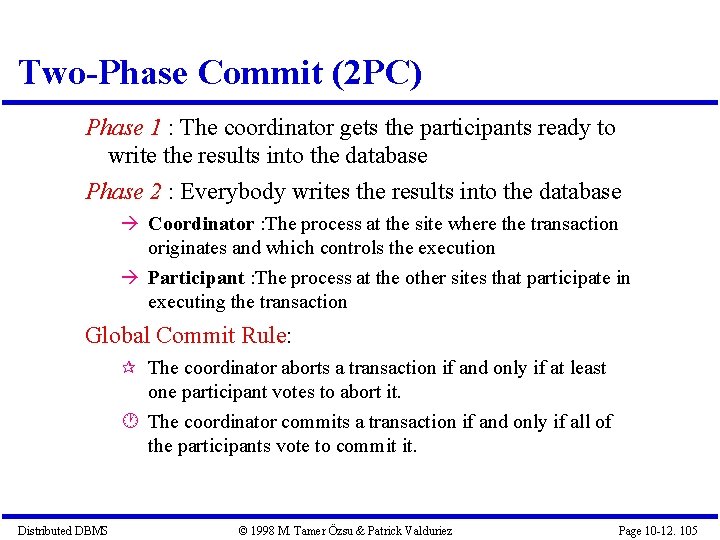
Two-Phase Commit (2 PC) Phase 1 : The coordinator gets the participants ready to write the results into the database Phase 2 : Everybody writes the results into the database Coordinator : The process at the site where the transaction originates and which controls the execution Participant : The process at the other sites that participate in executing the transaction Global Commit Rule: The coordinator aborts a transaction if and only if at least one participant votes to abort it. The coordinator commits a transaction if and only if all of the participants vote to commit it. Distributed DBMS © 1998 M. Tamer Özsu & Patrick Valduriez Page 10 -12. 105
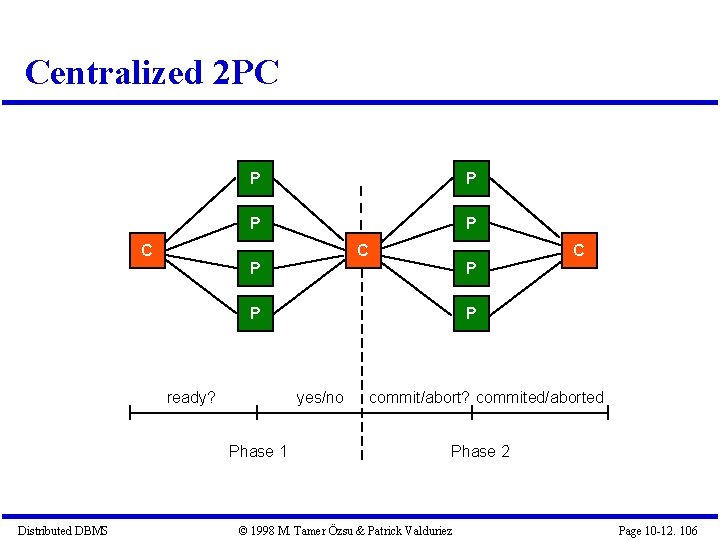
Centralized 2 PC P P C C P P ready? yes/no Phase 1 Distributed DBMS C commit/abort? commited/aborted Phase 2 © 1998 M. Tamer Özsu & Patrick Valduriez Page 10 -12. 106

2 PC Protocol Actions Coordinator Participant INITIAL PREP write begin_commit in log VOT write abort in log ORT No E-AB Yes write ready in log GLOBAL-ABORT write abort in log M -COM No VOTE Abort ACK ABORT ACK write end_of_transaction in log Distributed DBMS READY IT write commit in log COMMIT Ready to Commit? Yes VOTE-COMMIT WAIT Any No? ARE write abort in log ABORT © 1998 M. Tamer Özsu & Patrick Valduriez Type of msg Commit write commit in log COMMIT Page 10 -12. 107
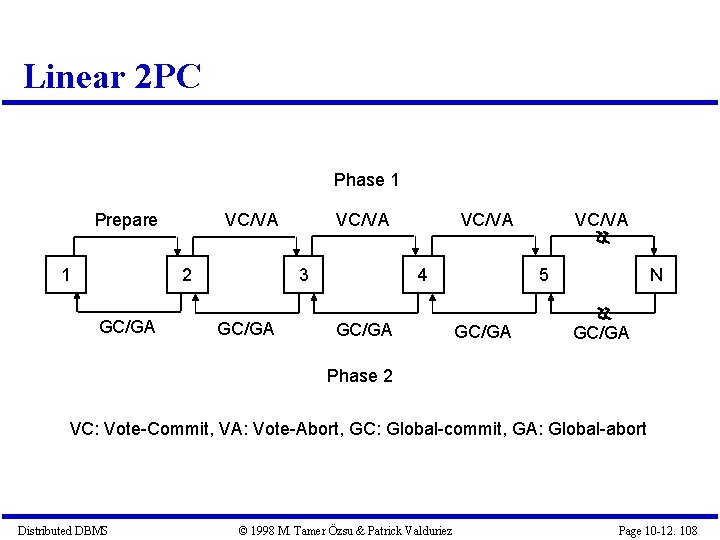
Linear 2 PC Phase 1 Prepare 1 VC/VA 2 GC/GA VC/VA 3 GC/GA VC/VA 4 GC/GA VC/VA 5 GC/GA N GC/GA Phase 2 VC: Vote-Commit, VA: Vote-Abort, GC: Global-commit, GA: Global-abort Distributed DBMS © 1998 M. Tamer Özsu & Patrick Valduriez Page 10 -12. 108
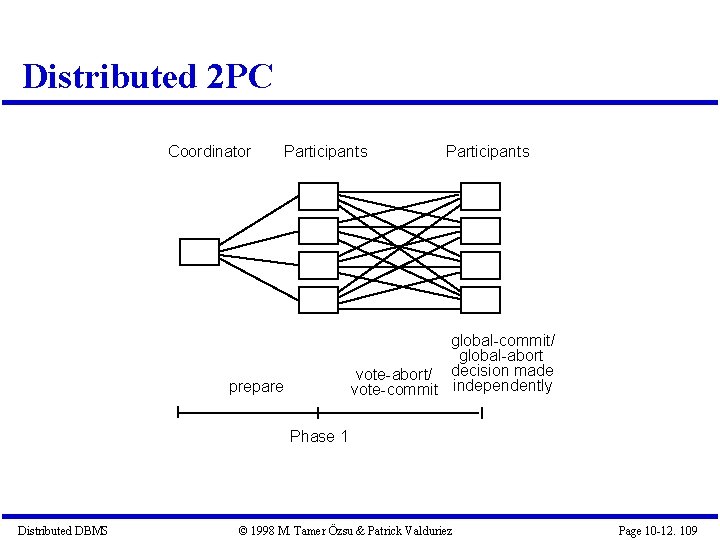
Distributed 2 PC Coordinator Participants global-commit/ global-abort vote-abort/ decision made vote-commit independently prepare Phase 1 Distributed DBMS © 1998 M. Tamer Özsu & Patrick Valduriez Page 10 -12. 109
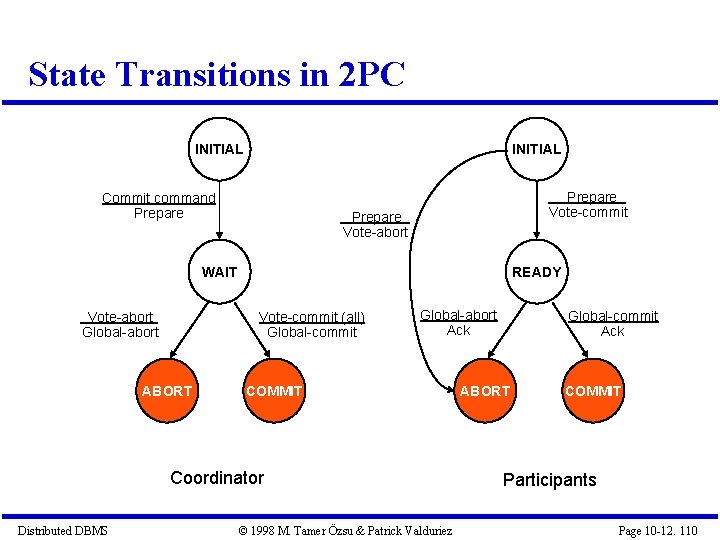
State Transitions in 2 PC INITIAL Commit command Prepare Vote-commit Prepare Vote-abort WAIT Vote-abort Global-abort READY Vote-commit (all) Global-commit ABORT Global-abort Ack COMMIT Coordinator Distributed DBMS © 1998 M. Tamer Özsu & Patrick Valduriez Global-commit Ack ABORT COMMIT Participants Page 10 -12. 110
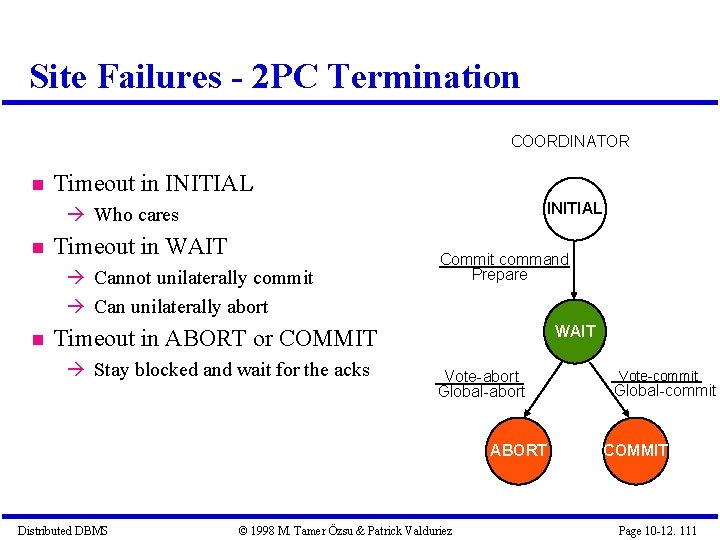
Site Failures - 2 PC Termination COORDINATOR Timeout in INITIAL Who cares Timeout in WAIT Cannot unilaterally commit Can unilaterally abort Commit command Prepare WAIT Timeout in ABORT or COMMIT Stay blocked and wait for the acks Vote-abort Global-abort ABORT Distributed DBMS © 1998 M. Tamer Özsu & Patrick Valduriez Vote-commit Global-commit COMMIT Page 10 -12. 111
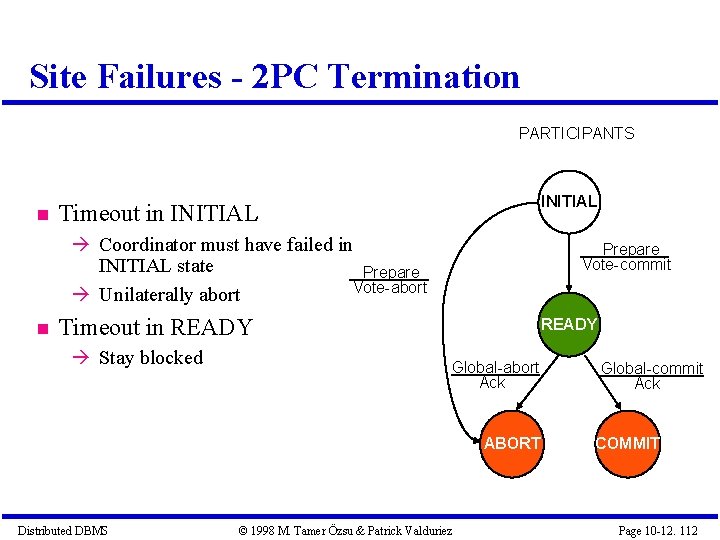
Site Failures - 2 PC Termination PARTICIPANTS INITIAL Timeout in INITIAL Coordinator must have failed in INITIAL state Prepare Vote-abort Unilaterally abort Prepare Vote-commit Timeout in READY Stay blocked READY Global-abort Ack ABORT Distributed DBMS © 1998 M. Tamer Özsu & Patrick Valduriez Global-commit Ack COMMIT Page 10 -12. 112
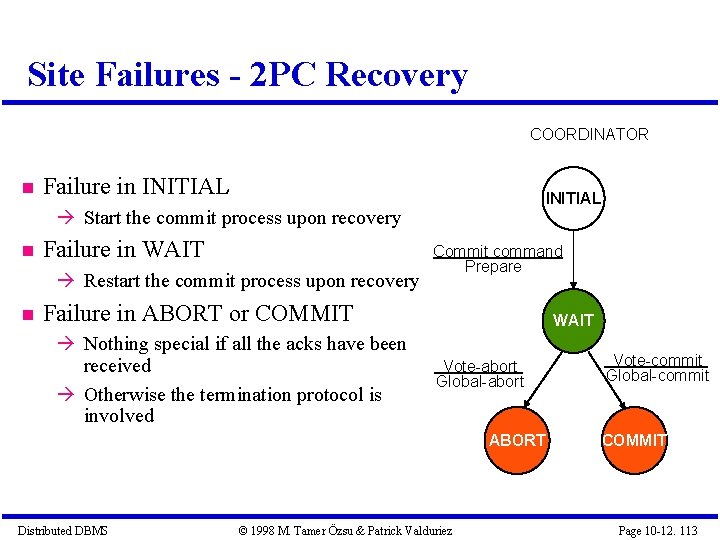
Site Failures - 2 PC Recovery COORDINATOR Failure in INITIAL Start the commit process upon recovery Failure in WAIT Restart the commit process upon recovery Commit command Prepare Failure in ABORT or COMMIT Nothing special if all the acks have been received Otherwise the termination protocol is involved WAIT Vote-abort Global-abort ABORT Distributed DBMS © 1998 M. Tamer Özsu & Patrick Valduriez Vote-commit Global-commit COMMIT Page 10 -12. 113
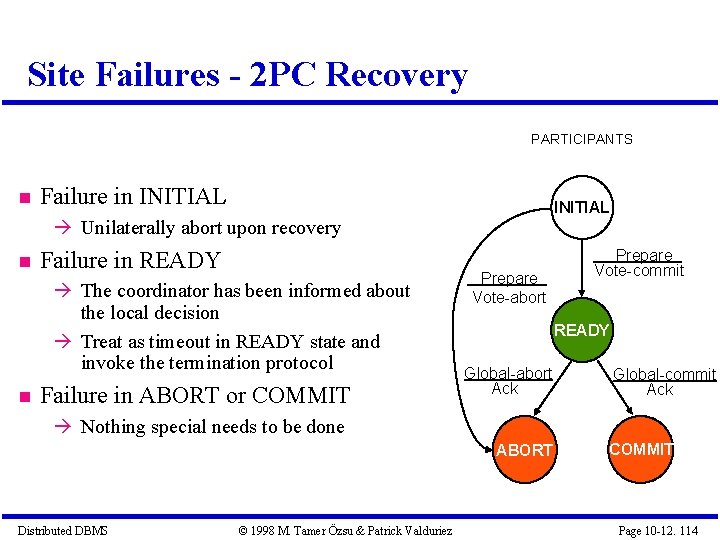
Site Failures - 2 PC Recovery PARTICIPANTS Failure in INITIAL Unilaterally abort upon recovery Failure in READY The coordinator has been informed about the local decision Treat as timeout in READY state and invoke the termination protocol Failure in ABORT or COMMIT Prepare Vote-abort Prepare Vote-commit READY Global-abort Ack Global-commit Ack Nothing special needs to be done ABORT Distributed DBMS © 1998 M. Tamer Özsu & Patrick Valduriez COMMIT Page 10 -12. 114
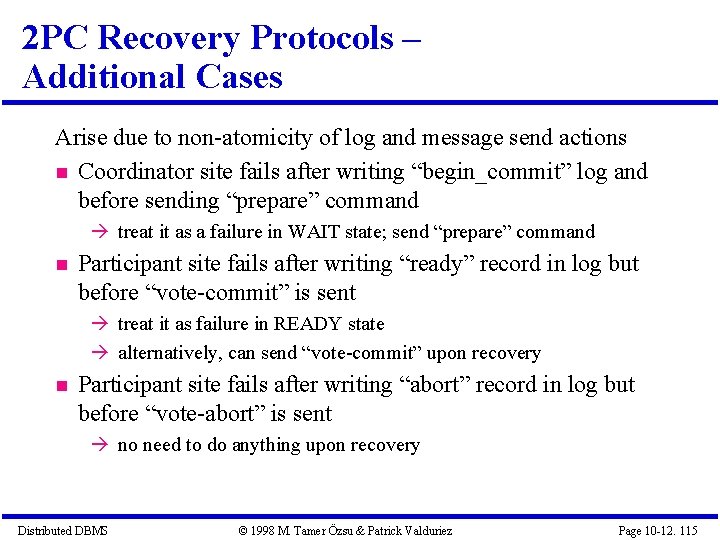
2 PC Recovery Protocols – Additional Cases Arise due to non-atomicity of log and message send actions Coordinator site fails after writing “begin_commit” log and before sending “prepare” command treat it as a failure in WAIT state; send “prepare” command Participant site fails after writing “ready” record in log but before “vote-commit” is sent treat it as failure in READY state alternatively, can send “vote-commit” upon recovery Participant site fails after writing “abort” record in log but before “vote-abort” is sent no need to do anything upon recovery Distributed DBMS © 1998 M. Tamer Özsu & Patrick Valduriez Page 10 -12. 115
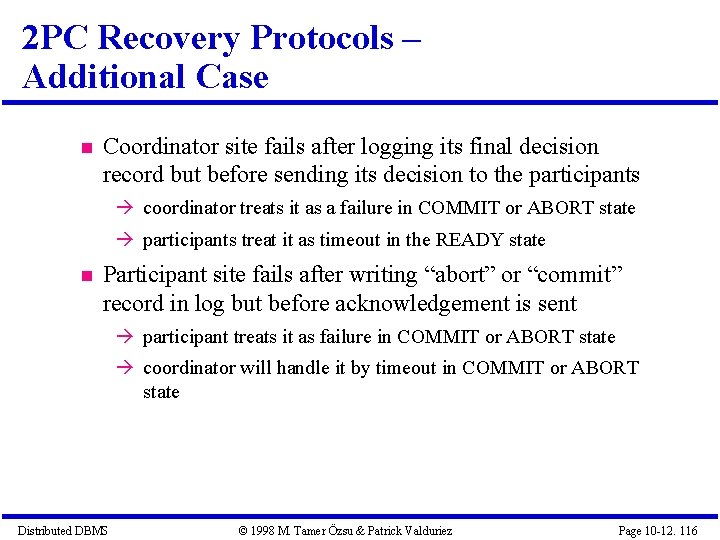
2 PC Recovery Protocols – Additional Case Coordinator site fails after logging its final decision record but before sending its decision to the participants coordinator treats it as a failure in COMMIT or ABORT state participants treat it as timeout in the READY state Participant site fails after writing “abort” or “commit” record in log but before acknowledgement is sent participant treats it as failure in COMMIT or ABORT state coordinator will handle it by timeout in COMMIT or ABORT state Distributed DBMS © 1998 M. Tamer Özsu & Patrick Valduriez Page 10 -12. 116
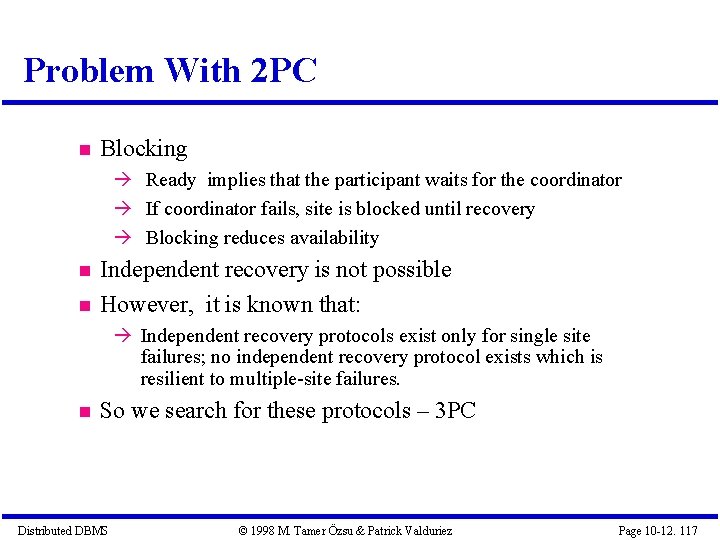
Problem With 2 PC Blocking Ready implies that the participant waits for the coordinator If coordinator fails, site is blocked until recovery Blocking reduces availability Independent recovery is not possible However, it is known that: Independent recovery protocols exist only for single site failures; no independent recovery protocol exists which is resilient to multiple-site failures. So we search for these protocols – 3 PC Distributed DBMS © 1998 M. Tamer Özsu & Patrick Valduriez Page 10 -12. 117
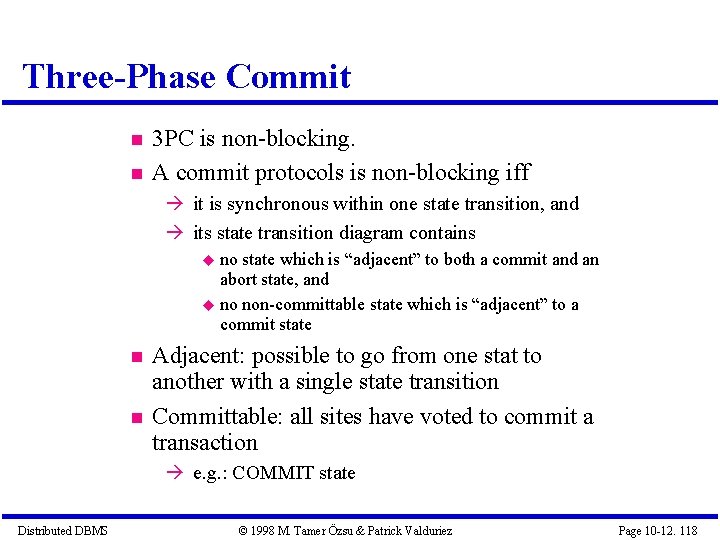
Three-Phase Commit 3 PC is non-blocking. A commit protocols is non-blocking iff it is synchronous within one state transition, and its state transition diagram contains no state which is “adjacent” to both a commit and an abort state, and no non-committable state which is “adjacent” to a commit state Adjacent: possible to go from one stat to another with a single state transition Committable: all sites have voted to commit a transaction e. g. : COMMIT state Distributed DBMS © 1998 M. Tamer Özsu & Patrick Valduriez Page 10 -12. 118
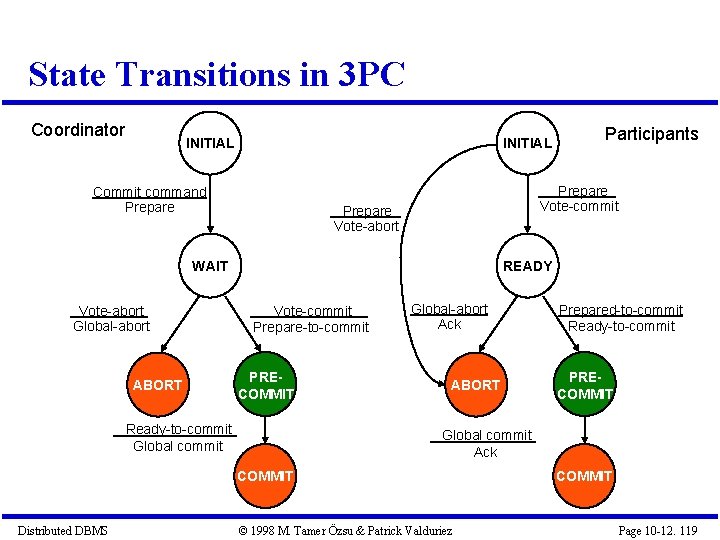
State Transitions in 3 PC Coordinator INITIAL Commit command Prepare Vote-commit Prepare Vote-abort WAIT Vote-abort Global-abort ABORT READY Vote-commit Prepare-to-commit PRECOMMIT Ready-to-commit Global-abort Ack ABORT Prepared-to-commit Ready-to-commit PRECOMMIT Global commit Ack COMMIT Distributed DBMS Participants © 1998 M. Tamer Özsu & Patrick Valduriez COMMIT Page 10 -12. 119
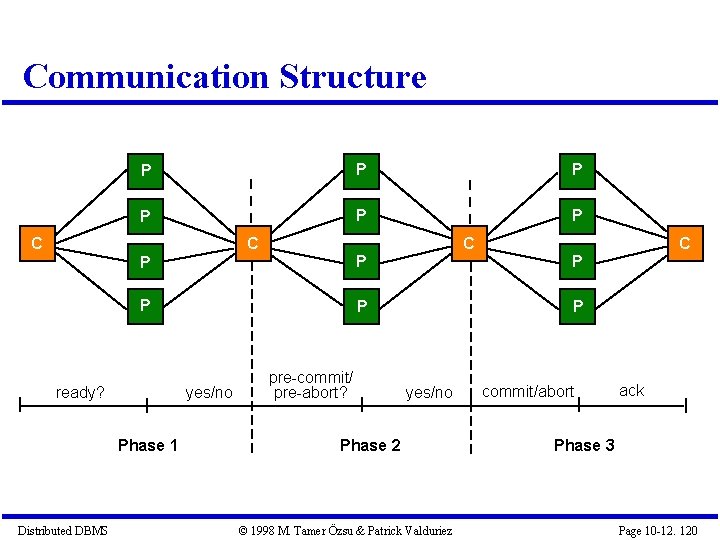
Communication Structure P P P C C C P P P ready? yes/no Phase 1 Distributed DBMS C pre-commit/ pre-abort? yes/no Phase 2 © 1998 M. Tamer Özsu & Patrick Valduriez commit/abort ack Phase 3 Page 10 -12. 120
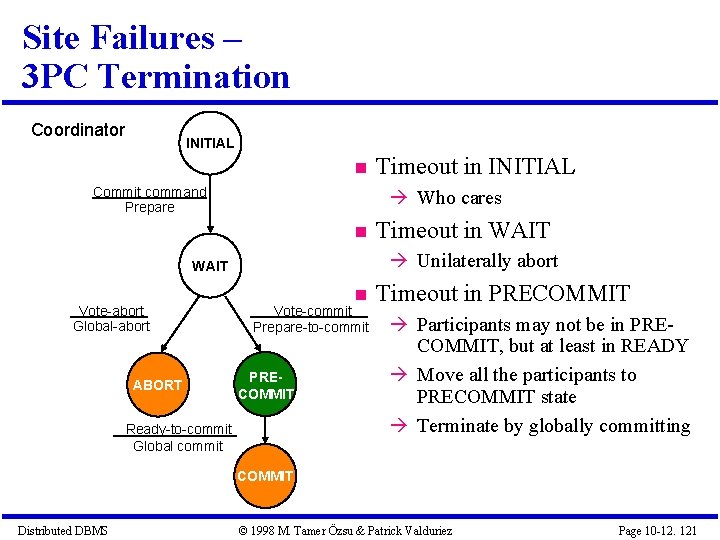
Site Failures – 3 PC Termination Coordinator INITIAL Commit command Prepare Who cares ABORT Timeout in WAIT Unilaterally abort WAIT Vote-abort Global-abort Timeout in INITIAL Vote-commit Prepare-to-commit PRECOMMIT Ready-to-commit Global commit Timeout in PRECOMMIT Participants may not be in PRECOMMIT, but at least in READY Move all the participants to PRECOMMIT state Terminate by globally committing COMMIT Distributed DBMS © 1998 M. Tamer Özsu & Patrick Valduriez Page 10 -12. 121
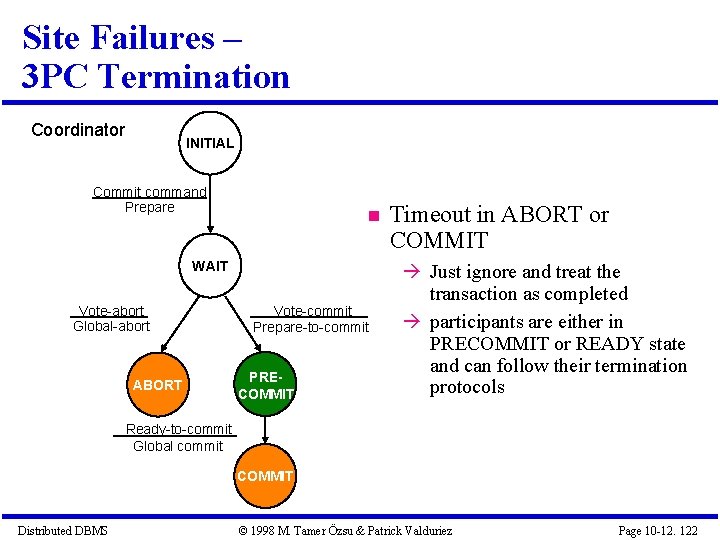
Site Failures – 3 PC Termination Coordinator INITIAL Commit command Prepare WAIT Vote-abort Global-abort ABORT Vote-commit Prepare-to-commit PRECOMMIT Timeout in ABORT or COMMIT Just ignore and treat the transaction as completed participants are either in PRECOMMIT or READY state and can follow their termination protocols Ready-to-commit Global commit COMMIT Distributed DBMS © 1998 M. Tamer Özsu & Patrick Valduriez Page 10 -12. 122
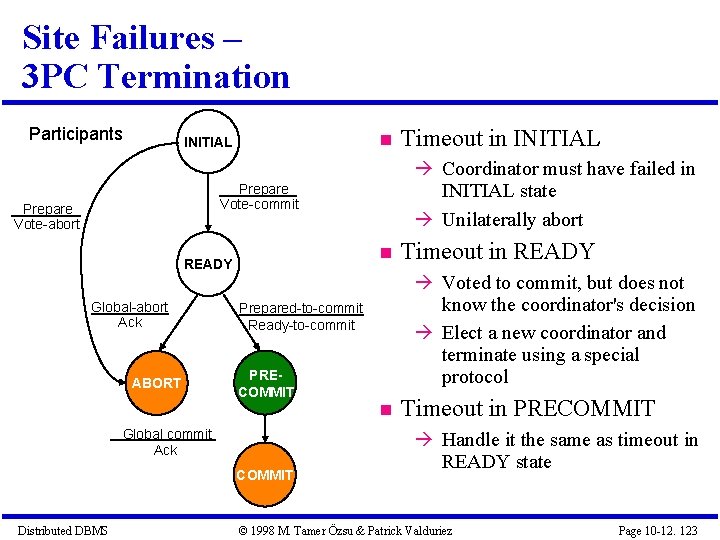
Site Failures – 3 PC Termination Participants INITIAL Coordinator must have failed in INITIAL state Unilaterally abort Prepare Vote-commit Prepare Vote-abort READY Global-abort Ack ABORT Global commit Ack COMMIT Distributed DBMS Timeout in READY Voted to commit, but does not know the coordinator's decision Elect a new coordinator and terminate using a special protocol Prepared-to-commit Ready-to-commit PRECOMMIT Timeout in INITIAL Timeout in PRECOMMIT Handle it the same as timeout in READY state © 1998 M. Tamer Özsu & Patrick Valduriez Page 10 -12. 123
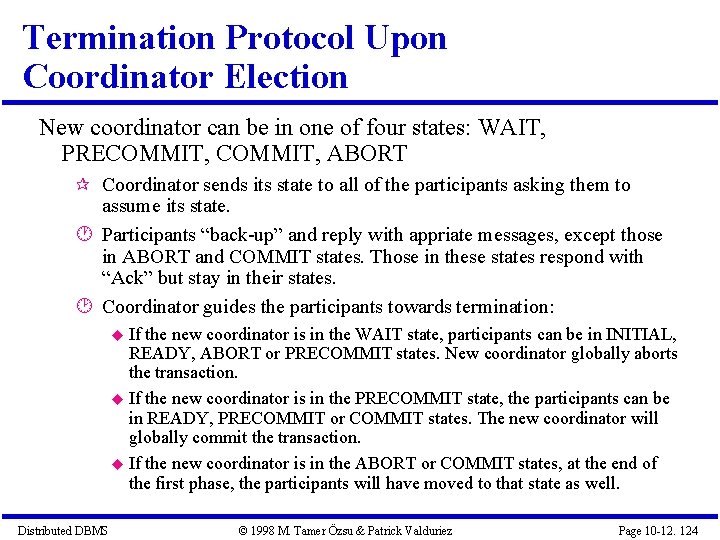
Termination Protocol Upon Coordinator Election New coordinator can be in one of four states: WAIT, PRECOMMIT, ABORT Coordinator sends its state to all of the participants asking them to assume its state. Participants “back-up” and reply with appriate messages, except those in ABORT and COMMIT states. Those in these states respond with “Ack” but stay in their states. Coordinator guides the participants towards termination: If the new coordinator is in the WAIT state, participants can be in INITIAL, READY, ABORT or PRECOMMIT states. New coordinator globally aborts the transaction. If the new coordinator is in the PRECOMMIT state, the participants can be in READY, PRECOMMIT or COMMIT states. The new coordinator will globally commit the transaction. If the new coordinator is in the ABORT or COMMIT states, at the end of the first phase, the participants will have moved to that state as well. Distributed DBMS © 1998 M. Tamer Özsu & Patrick Valduriez Page 10 -12. 124
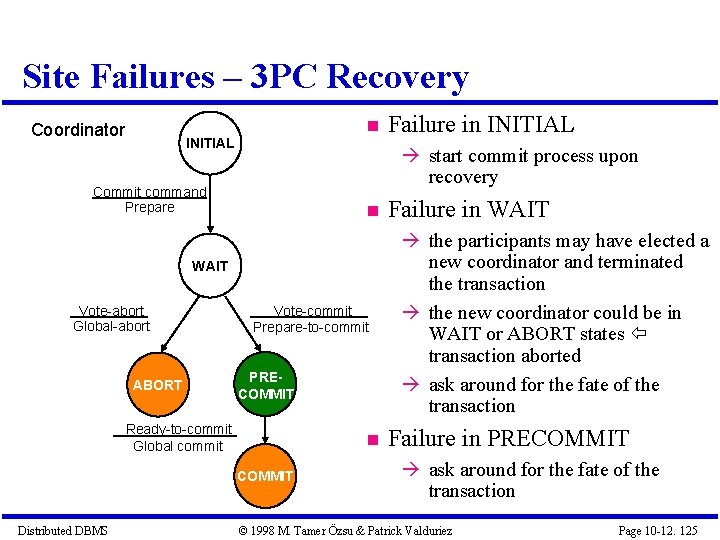
Site Failures – 3 PC Recovery Coordinator INITIAL start commit process upon recovery Commit command Prepare WAIT Vote-abort Global-abort ABORT Vote-commit Prepare-to-commit PRECOMMIT Ready-to-commit Global commit COMMIT Distributed DBMS Failure in INITIAL Failure in WAIT the participants may have elected a new coordinator and terminated the transaction the new coordinator could be in WAIT or ABORT states transaction aborted ask around for the fate of the transaction Failure in PRECOMMIT ask around for the fate of the transaction © 1998 M. Tamer Özsu & Patrick Valduriez Page 10 -12. 125
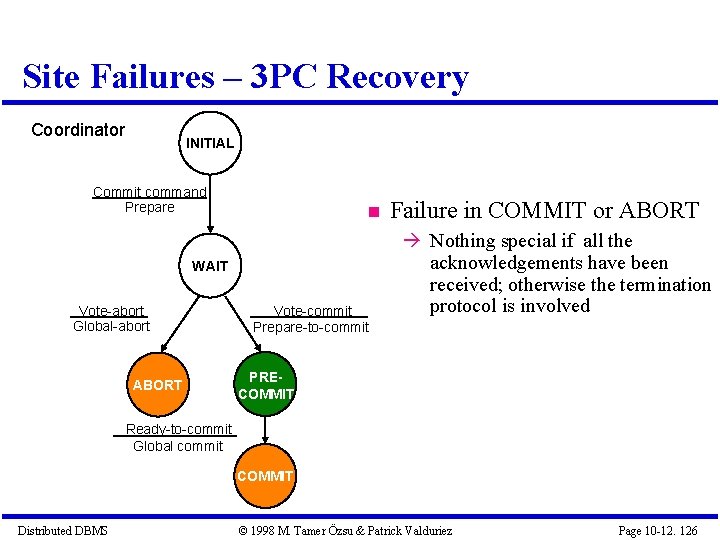
Site Failures – 3 PC Recovery Coordinator INITIAL Commit command Prepare WAIT Vote-abort Global-abort ABORT Vote-commit Prepare-to-commit Failure in COMMIT or ABORT Nothing special if all the acknowledgements have been received; otherwise the termination protocol is involved PRECOMMIT Ready-to-commit Global commit COMMIT Distributed DBMS © 1998 M. Tamer Özsu & Patrick Valduriez Page 10 -12. 126
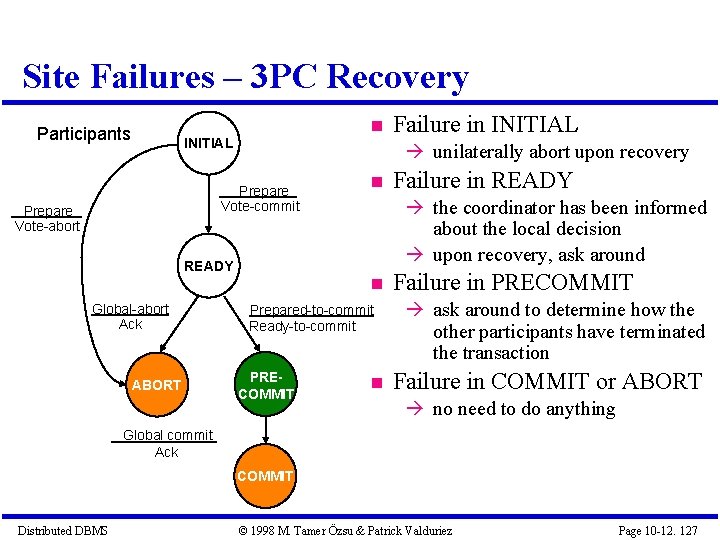
Site Failures – 3 PC Recovery Participants INITIAL unilaterally abort upon recovery Prepare Vote-commit Prepare Vote-abort READY Global-abort Ack ABORT Failure in INITIAL the coordinator has been informed about the local decision upon recovery, ask around Prepared-to-commit Ready-to-commit PRECOMMIT Failure in READY Failure in PRECOMMIT ask around to determine how the other participants have terminated the transaction Failure in COMMIT or ABORT no need to do anything Global commit Ack COMMIT Distributed DBMS © 1998 M. Tamer Özsu & Patrick Valduriez Page 10 -12. 127
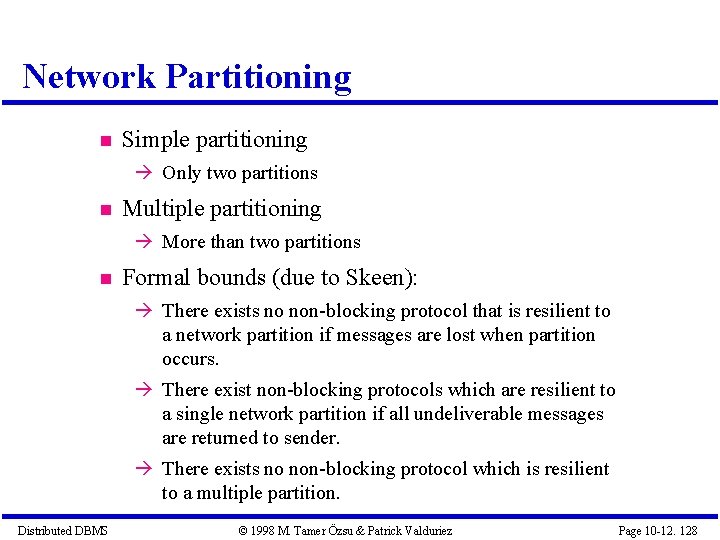
Network Partitioning Simple partitioning Only two partitions Multiple partitioning More than two partitions Formal bounds (due to Skeen): There exists no non-blocking protocol that is resilient to a network partition if messages are lost when partition occurs. There exist non-blocking protocols which are resilient to a single network partition if all undeliverable messages are returned to sender. There exists no non-blocking protocol which is resilient to a multiple partition. Distributed DBMS © 1998 M. Tamer Özsu & Patrick Valduriez Page 10 -12. 128
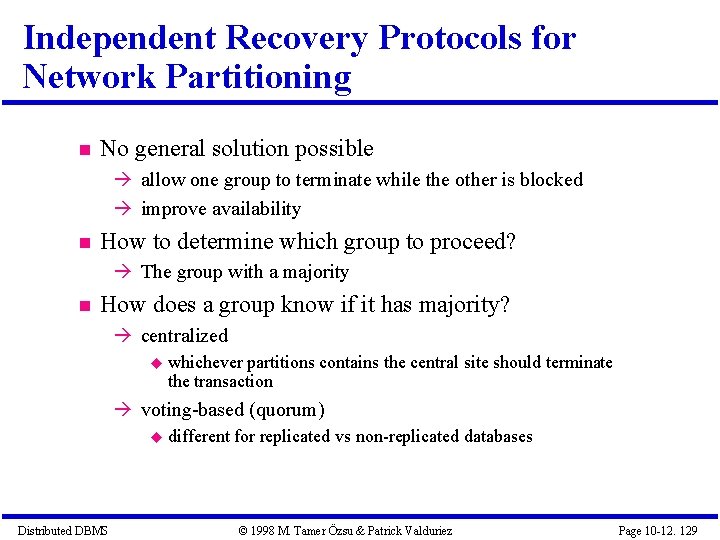
Independent Recovery Protocols for Network Partitioning No general solution possible allow one group to terminate while the other is blocked improve availability How to determine which group to proceed? The group with a majority How does a group know if it has majority? centralized whichever partitions contains the central site should terminate the transaction voting-based (quorum) different Distributed DBMS for replicated vs non-replicated databases © 1998 M. Tamer Özsu & Patrick Valduriez Page 10 -12. 129
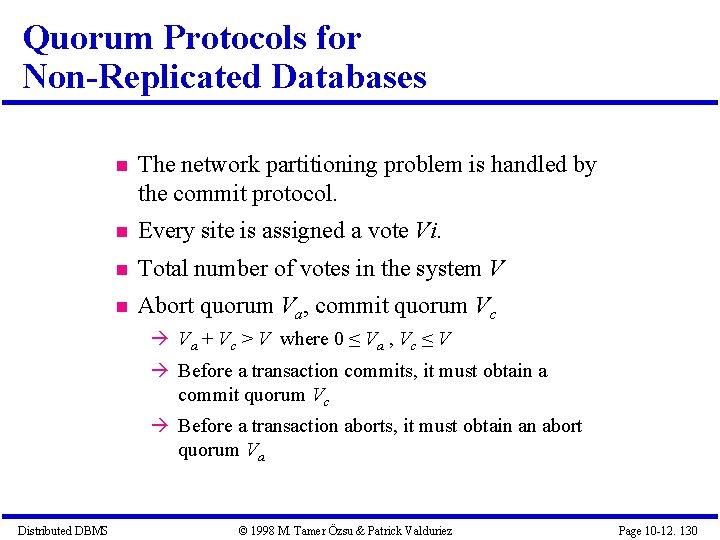
Quorum Protocols for Non-Replicated Databases The network partitioning problem is handled by the commit protocol. Every site is assigned a vote Vi. Total number of votes in the system V Abort quorum Va, commit quorum Vc Va + Vc > V where 0 ≤ Va , Vc ≤ V Before a transaction commits, it must obtain a commit quorum Vc Before a transaction aborts, it must obtain an abort quorum Va Distributed DBMS © 1998 M. Tamer Özsu & Patrick Valduriez Page 10 -12. 130
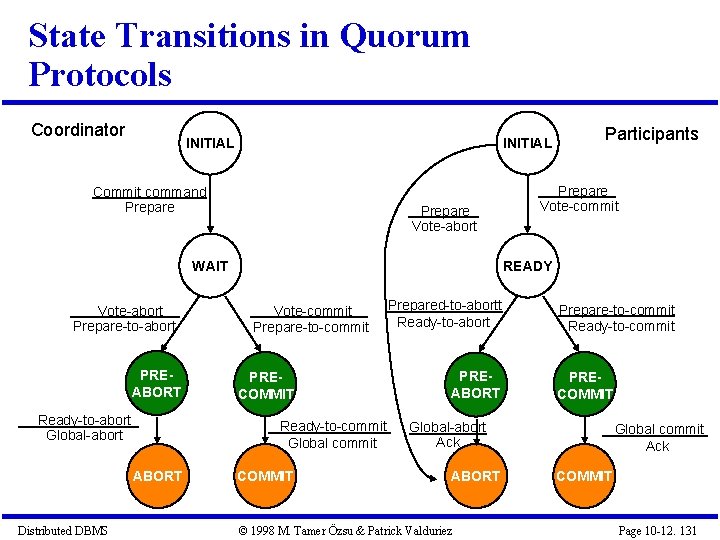
State Transitions in Quorum Protocols Coordinator INITIAL Commit command Prepare Vote-abort WAIT Vote-abort Prepare-to-abort PREABORT Ready-to-abort Global-abort Distributed DBMS Prepare Vote-commit READY Vote-commit Prepare-to-commit PRECOMMIT Ready-to-commit Global commit ABORT Participants COMMIT Prepared-to-abortt Ready-to-abort PREABORT Prepare-to-commit Ready-to-commit PRECOMMIT Global-abort Ack ABORT © 1998 M. Tamer Özsu & Patrick Valduriez Global commit Ack COMMIT Page 10 -12. 131
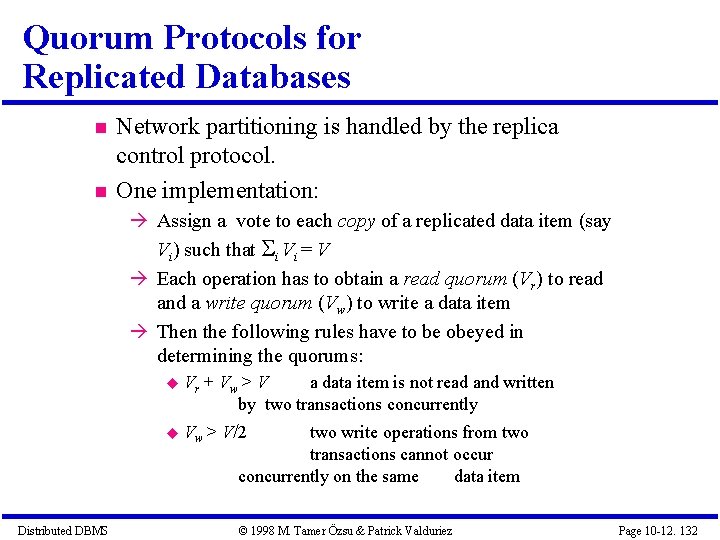
Quorum Protocols for Replicated Databases Network partitioning is handled by the replica control protocol. One implementation: Assign a vote to each copy of a replicated data item (say Vi) such that i Vi = V Each operation has to obtain a read quorum (Vr) to read and a write quorum (Vw) to write a data item Then the following rules have to be obeyed in determining the quorums: Distributed DBMS Vr + Vw > V a data item is not read and written by two transactions concurrently Vw > V/2 two write operations from two transactions cannot occur concurrently on the same data item © 1998 M. Tamer Özsu & Patrick Valduriez Page 10 -12. 132
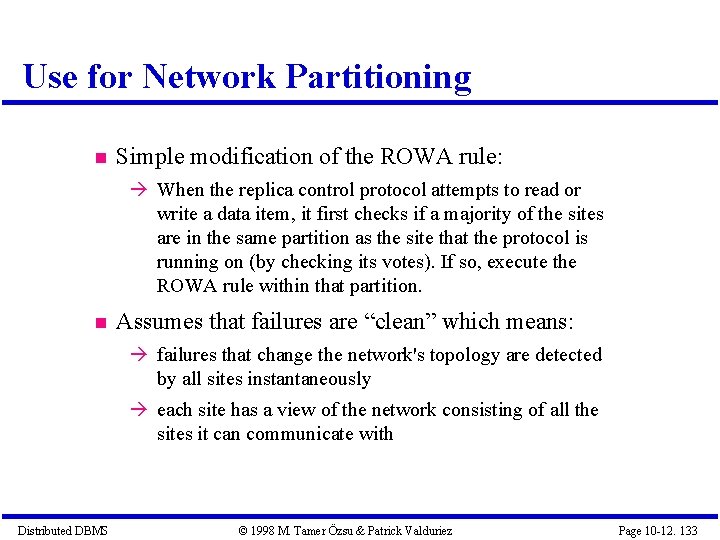
Use for Network Partitioning Simple modification of the ROWA rule: When the replica control protocol attempts to read or write a data item, it first checks if a majority of the sites are in the same partition as the site that the protocol is running on (by checking its votes). If so, execute the ROWA rule within that partition. Assumes that failures are “clean” which means: failures that change the network's topology are detected by all sites instantaneously each site has a view of the network consisting of all the sites it can communicate with Distributed DBMS © 1998 M. Tamer Özsu & Patrick Valduriez Page 10 -12. 133
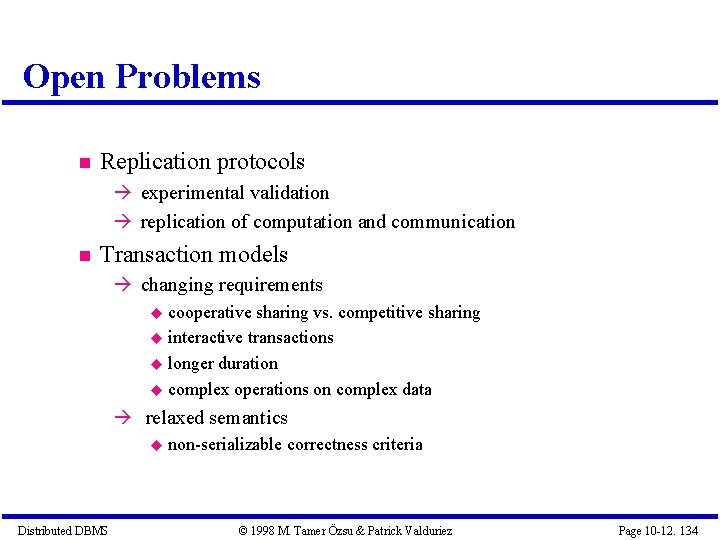
Open Problems Replication protocols experimental validation replication of computation and communication Transaction models changing requirements cooperative sharing vs. competitive sharing interactive transactions longer duration complex operations on complex data relaxed semantics non-serializable Distributed DBMS correctness criteria © 1998 M. Tamer Özsu & Patrick Valduriez Page 10 -12. 134
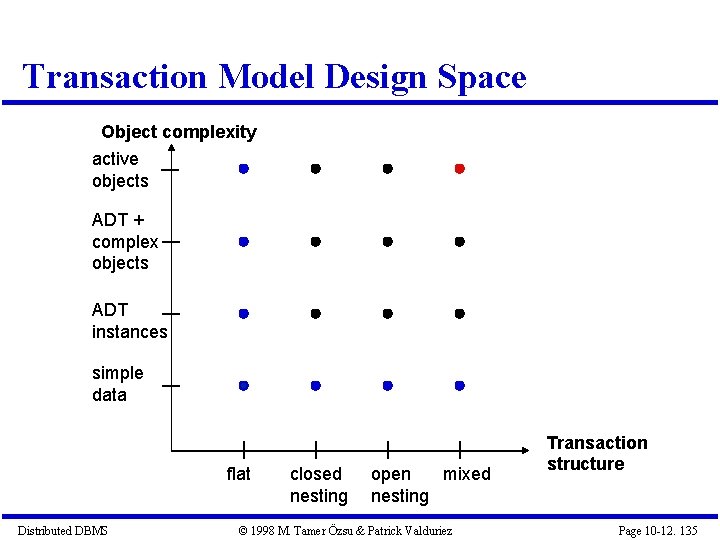
Transaction Model Design Space Object complexity active objects ADT + complex objects ADT instances simple data flat Distributed DBMS closed nesting open mixed nesting © 1998 M. Tamer Özsu & Patrick Valduriez Transaction structure Page 10 -12. 135
- Slides: 135